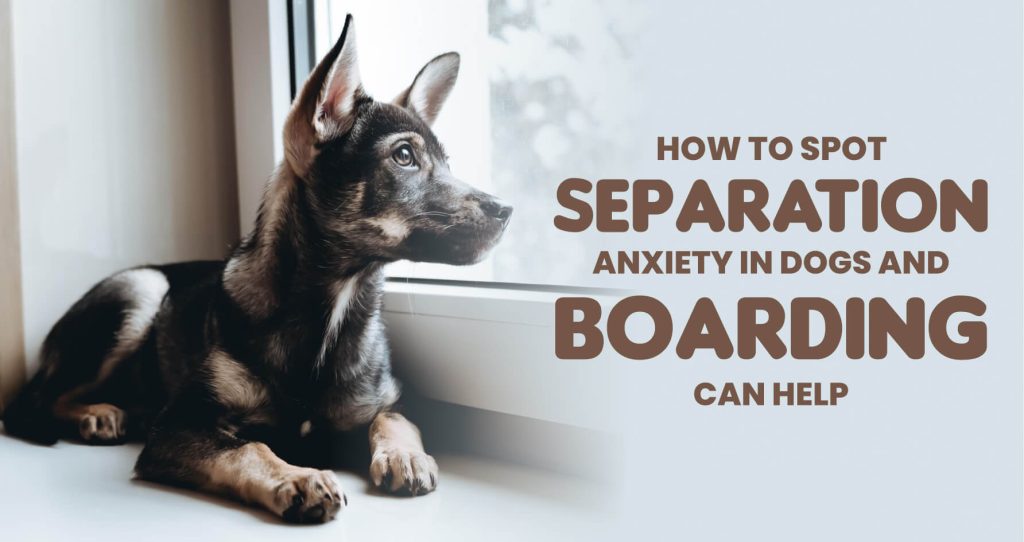As pet parents, we all want our dogs to be happy, comfortable, and secure. However, sometimes, when left alone or separated from their owners, some dogs experience separation anxiety. This common condition can be difficult for both the dog and the owner to deal with, leading to distressing behaviors and emotional strain. At Chippis Pet Boarding, we understand how important it is to manage your dog’s well-being during stressful situations, and we’re here to help.
In this blog, we’ll explain how to spot the signs of separation anxiety in dogs and how pet boarding can actually play a vital role in alleviating this condition.
What Is Separation Anxiety in Dogs?

Separation anxiety occurs when a dog feels extreme stress or fear when separated from their owner. This anxiety can lead to a variety of behavioral issues, as dogs try to cope with the emotional distress of being alone. While mild cases of separation anxiety are relatively common, more severe cases can cause serious damage to your home or harm to your pet.
At Chippis Pet Boarding, we see a variety of dogs with different levels of anxiety, and we’re well-equipped to provide them with the care and comfort they need. Recognizing the signs early can make all the difference in managing the condition and ensuring your dog is happy and safe.
Signs of Separation Anxiety in Dogs
It’s important to understand the signs of separation anxiety so you can address the issue as soon as possible. Common signs include:
- Excessive Barking or Howling
Dogs with separation anxiety often vocalize loudly when left alone. They may bark, howl, or whine continuously, which can be distressing for neighbors and stressful for the dog. This behavior typically starts shortly after the owner leaves and can last for an extended period. - Destructive Behavior
A dog experiencing separation anxiety might chew on furniture, shoes, doors, or other household items. This destruction is often an attempt to cope with stress and frustration when left alone. - Accidents in the House
Even if your dog is house-trained, they may have accidents when they experience separation anxiety. These accidents usually occur when the dog is left alone for extended periods of time, causing them distress. - Pacing or Restlessness
Dogs with separation anxiety may appear restless, pacing back and forth or following their owner from room to room. This behavior often intensifies as the owner prepares to leave, signaling an impending separation. - Salivation or Drooling
Excessive drooling or salivation is another common sign. It’s a physical response to anxiety and stress, often accompanied by panting or trembling. - Escape Attempts
Some dogs with severe separation anxiety might try to escape from their crate, room, or even the home. They may attempt to dig, scratch, or claw their way out in an effort to reunite with their owner.
How Boarding Can Help Alleviate Separation Anxiety

While dealing with separation anxiety can be challenging, it’s not something you have to face alone. Pet boarding can be an excellent solution for dogs suffering from this condition, and here’s why:
- Safe and Structured Environment
At Chippis Pet Boarding, we offer a calm and structured environment where your dog can feel safe and secure. Boarding facilities can provide a routine that helps ease the anxiety that arises from being at home alone. With consistent meal times, exercise routines, and rest periods, your dog can adjust to their surroundings and feel more at ease. - Socialization and Distraction
One of the most effective ways to combat separation anxiety is by keeping your dog mentally and physically stimulated. In a pet boarding setting, dogs have the opportunity to interact with other dogs, engage in playtime, and receive attention from trained staff members. This helps reduce feelings of loneliness and fear while providing positive distractions. - Professional Monitoring
Separation anxiety can sometimes require professional intervention, especially in more severe cases. Chippis Pet Boarding offers experienced staff who are well-trained in recognizing and managing anxiety-related behaviors. Our team knows how to offer the right kind of support to help your dog feel more comfortable. We monitor your pet carefully, offering gentle care and attention while reducing the potential for negative behaviors. - A Break from Home Triggers
At home, dogs with separation anxiety might be triggered by certain sounds or experiences, like the rustling of keys or the sound of a door closing. When they are at Chippis Pet Boarding, they are in a new environment, which can help reduce exposure to these triggers. A change of scenery may allow your dog to relax, knowing they’re in a safe place where their usual stressors are minimized. - Gradual Transition to Alone Time
Boarding can also be a helpful way to gradually ease your dog into being left alone for longer periods of time. The process can begin with short stays and progressively increase in length, allowing your dog to build up their tolerance to being apart from you. This structured approach can help your dog learn that being apart from you doesn’t have to be a source of stress.
How to Help Your Dog at Home

While pet boarding can be an effective solution, managing separation anxiety also requires ongoing effort at home. Here are a few additional tips:
- Gradually increase alone time at home so your dog gets used to being alone without feeling overwhelmed.
- Create a designated “safe space” where your dog can feel comfortable when you leave.
- Use puzzle toys or calming music to keep your dog entertained and relaxed while you’re gone.
Final Thoughts
Separation anxiety is a tough challenge for both dogs and their owners, but with the right support and understanding, it can be managed. If your dog suffers from separation anxiety, Chippis Pet Boarding can help provide a calm, safe environment where they can feel secure while you’re away. Our experienced team ensures your dog receives personalized care, attention, and support to ease their anxiety and make their stay as enjoyable as possible.




